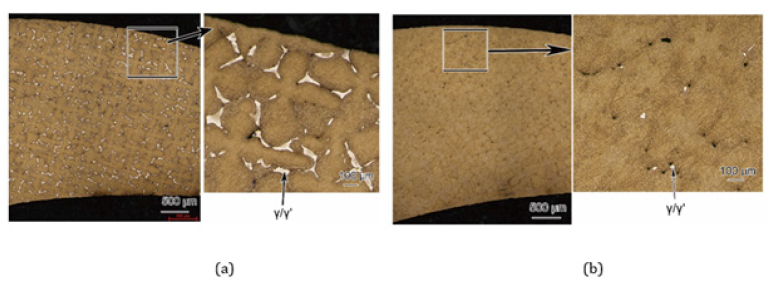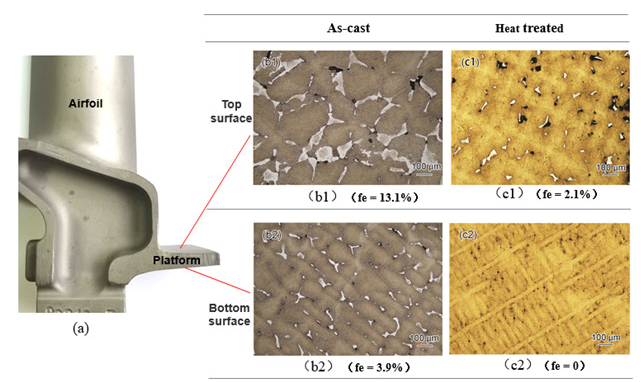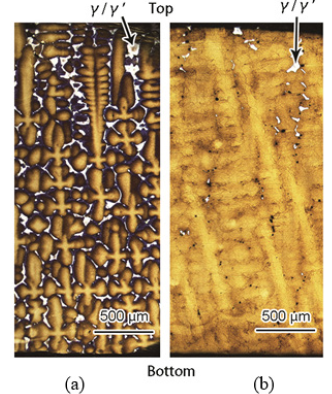- Submissions

Full Text
Research & Development in Material Science
Experimental Observation on the Upward Accumulation of Eutectic in Single Crystal Superalloy Castings
Dexin Ma1* and Yunxing Zhao2
1Shenzhen Wedge Central South Research Institute Co. Ltd., China
2Powder Metallurgy Research Institute, Central South University, China
*Corresponding author:Dexin Ma, Shenzhen Wedge Central South Research Institute Co. Ltd., Shenzhen 518045, Chinaa
Submission: March 17, 2023;Published: April 10, 2023

ISSN: 2576-8840 Volume 18 Issue 3
Abstract
The γ/γ’-eutectic structure in the single crystal blade castings of superalloy CMSX-4 was examined. It was observed that the as-cast eutectic in the airfoil region was uniformly distributed and could be nearly completely eliminated during solution heat treatment. In the platform, however, significant difference in the eutectic appearance between top and bottom surface was detected. The as-cast eutectic in the top region was measure to be several times more than that at the bottom. Even after standard heat treatment, there is still a number of residual eutectic remaining undissolved at the platform top. This phenomenon, called as upward accumulation of eutectic structure, is attributed to the upward transmission of γ′-forming elements by means of diffusion and convection, resulting in an eutectic concentrated region at the top of the casting part.
Keywords:Superalloy; Single crystal; Blade casting; Eutectic; Upward accumulation
Short Communication
Aero-engine is the most advanced product in modern manufacturing industry, in which the Single Crystal (SC) blades of superalloys are the most important components. At present, all advanced aero-engines are characterized by the application of SC blades, which are fabricated by directional solidification technology. During the solidification process, the γ phase grows from the alloy melt in the form of columnar dendrite, and the γ/γ′-eutectic phase precipitates from the interdendritic residual liquid at the final step of the solidification process. In order to improve the strengthening effect of precipitation phase in the alloy, more and more γ′-phase forming elements were added. This makes the volume fraction of γ/γ′- eutectic in the as-cast structure increase continuously. In the as-cast microstructure of the second and third generation SC superalloys, the γ/γ′-fraction may even exceed 10% [1]. In the past few decades, the study of eutectic structure has mainly focused on the morphology, size and volume fraction of eutectic with solidification conditions [1-5]. In addition, the nucleation and growth of eutectic in the interdendritic liquid were studied in detail [6-8]. In this paper, the as-cast and solution heat treated microstructures of SC blade castings were investigated, to detect the distribution of eutectic in both structures
The alloy used in the experiment is the second-generation SC superalloy CMSX-4 with the nominal composition (wt pct) of 6.4Cr, 9.6Co, 0.6Mo, 6.4W, 6.6Ta, 2.9Re, 5.7Al, 1.0Ti, 0.1Hf, and rest Ni. A group of single crystal turbine blades were cast in an industrial vacuum furnace of Bridgman type. The applied heater temperature and pouring temperature were 1550 °C, and the withdrawal velocity of the mold shell poured with alloy melt was 3mm/min. After the casting process, the blade castings were knocked out of the ceramic mold and mechanically separated from the casting cluster. After the sand blasting the blades were etched to reveal the macrostructure. A part of the blade castings were used to investigate the eutectic distribution in as-cast structure. For the other part of castings, the solid solution heat treatment was carried out to detect the corresponding structure.
Figure 1(a) & (b) show the cross-sections of the blade airfoil before and after heat treatment respectively. The as-cast microstructure shown in Figure 1(a) consist of dark γ-dendrites and bright white γ/γ′-eutectic islands. It can be seen that the γ/γ′-eutectic structure is relatively uniformly distributed on the cross section, and the eutectic fraction in the as-cast microstructure was measured to be about fe = 6.5% . After solution heat treatment, the eutectic islands were basically eliminated (figure 1(b)), only a few small residual eutectic could be detected, which were distributed randomly in the cross section.
Figure 1:Cross sections of the blade airfoil in as-cast state (a) and after heat treatment (b).

The microstructure in the platforms of blade castings was also examined, as presented in Figure 2. Although the platform is only 3mm in thickness, there is a great difference in the γ/γ′- eutectic appearance between the top and the bottom surface of the platform. Figure 2(b1) shows the as-cast microstructure beneath the top surface. A large number of white bright γ/γ′-eutectic islands are present in the interdendritic region. The area fraction of the ascast γ/γ′-eutectic reaches a high value of fe=13.1%, as measured on the entire upper surface of the platform.
Figure 2:Photo of a blade casting part (a), and cross sections of a platform (b1, b2, c1, c2), revealing the as-cast structure and the heat treated structure, at the top and at the bottom, respectively.

Figure 2(b2) shows the as-cast microstructure beneath the bottom surface of the same platform. In this area only a small amount of fine γ/γ′-eutectic islands are observed. The area fraction of as-cast eutectic is about fe=3.9%, which is only 30% of that at the top surface (Figure 2(b1)), revealing an uneven distribution of ascast γ/γ′-eutectic in the blade platform.
The solution heat treatment process was applied to dissolve the as-cast eutectic and to reduce the chemical segregation of alloying elements in the blade castings. Figure 2(c2) shows the heat-treated microstructure at the platform bottom. Compared with the as-cast structure, as seen in Figure 2(b1), the eutectic in this region has been completely dissolved. However, in the top area of the platform, there are still a lot of residual eutectic (Figure 2(c1)) even after heat treatment. The area fraction of the residual eutectic is about fe=2.1%, so that the blade casting has to be rejected, for exceeding the residual eutectic standard of 1.5%.
The longitudinal sections of the blade platforms were also prepared in as-cast state and after heat treatment. Figure 3(a) presents the as-cast microstructure through the platform, in which the eutectic fraction increases gradually from the bottom to the top surface. After solution heat treatment (Figure 3(b)) , the eutectic structure in the bottom region was completely eliminated. In the middle region only some fine residual eutectic can be found. In the top region of the platform, however, there is still a lot of residual eutectic remaining undissolved, in spite of a standard solution heat treatment.
Figure 3:Longitudinal sections of the blade platform in as-cast state (a) and after heat treatment (b).

In order to explain the evolution of the eutectic structure, the solidification process from the bottom to the top of the platform is divided into the following three steps, as illustrated in Figure 4:
Figure 4:Schematics illustrating the formation of the as-cast structure from the bottom (a) through the middle (b) to the top of the platform (c).

a) In the bottom region, solidification takes place rapidly due
to the local undercooling, forming the fine dendrite structure.
The ’-forming elements Al+Ti+Ta segregate positively from
the dendrite core into the interdendritic liquid. Due to the
lower solid fraction and insufficient concentration of Al+Ti+Ta
at this stage, only a small amount of ’-phase can be formed in
the form of /’-eutectic.
b) In the middle region, the dendrites grow upward
continually. With the increase in the solid fraction, more and
more Al+Ti+Ta elements segregated into the interdendritic
liquid, so that more /’-eutectic are formed correspondingly.
At the same time, Al+Ti+Ta elements in the liquid transfer
upwards continually by means of diffusion and convection.
c) In the top region, the dendrite growth reaches the top
surface of the platform. Due to the slowdown of the solidification
and the accumulation of elements Al+Ti+Ta, a lot of coarse
/’-eutectic are formed, resulting in the phenomenon of
eutectic accumulation in the top region of the platform.
In summary, the microstructure in SC blade castings of superalloy CMSX-4 was detected. An uniform distribution of as-cast /’-eutectic was observed in the airfoil part, whose area fraction is about fe=6.5% in the cross section and can be almost eliminated after solution heat treatment. In comparison, a phenomenon of upward eutectic accumulation was found in the platform. The eutectic fraction at the top and at the bottom of the platform is about fe=13.1% and fe=3.9% respectively, revealing a significant difference in the eutectic distribution. This phenomenon is attributed to the upward transmission of ’-forming elements by means of diffusion and convection during the upward solidification process through the platform, which are finally enriched in the upper surface region and generate a large number of γ/γ′-eutectic. It should be pointed out that, the eutectic accumulation at the top of platform is so serious that a number of eutectic remains undissolved during standard heat treatment, resulting in the rejection of the SC blade castings.
Acknowledgement
This research was funded by the Shenzhen Peacock Plan (KQTD2015032716463668) and by the Guangdong Innovative and Entrepreneurial Research Team Program (607264877417).
References
- Seo S, Lee J, Yoo Y (2011) A comparative study of the γ/γ’ eutectic evolution during the solidification of Ni-base superalloys. Metallurgical and Materials Transactions A 42(10): 3150-3159.
- Souza ND, Dong HB, Ardakani MG (2005) Solidification path in the Ni-base superalloy IN713LC-quantitative correlation of last stage solidification. Scripta Materialia 53(6): 729-733.
- Wang F, Ma D, Zhang J (2014) Effect of solidification parameter on the microstructures of CMSX-6 formed during the downward directional solidification process. Journal of Crystal Growth 389: 47-54.
- Wang Fu, Ma D, Zhang J (2014) Effect of local cooling rates on the microstructures of single crystal CMSX-6 superalloy: a comparative assessment of the Bridgman and the downward directional solidification process. Journal of Alloys & Compounds 616: 102-109.
- Wang Fu, Ma D, Zhang J (2015) Solidification behavior of a Ni-based single crystal CMSX-4 superalloy solidified by downward directional solidification process. Materials Characterization 101: 20-25.
- Warnken N, Ma D, Mathes M (2005) Investigation of eutectic island formation in SX superalloys. Materials Science and Engineering A 413-414: 267-271.
- Souza N D, Dong H B (2007) Solidification path in third-generation Ni-based superalloys with an emphasis on last stage solidification. Scripta Materialia 56(1): 41-44.
- Souza ND, Lekstrom M, Dai HJ (2007) Quantitative characterization of last stage solidification in nickel base superalloy using enthalpy based method. Materials Science and Technology 23(9): 1085-1092.
© 2023 Dexin Ma. This is an open access article distributed under the terms of the Creative Commons Attribution License , which permits unrestricted use, distribution, and build upon your work non-commercially.
 a Creative Commons Attribution 4.0 International License. Based on a work at www.crimsonpublishers.com.
Best viewed in
a Creative Commons Attribution 4.0 International License. Based on a work at www.crimsonpublishers.com.
Best viewed in 







.jpg)






























 Editorial Board Registrations
Editorial Board Registrations Submit your Article
Submit your Article Refer a Friend
Refer a Friend Advertise With Us
Advertise With Us
.jpg)






.jpg)














.bmp)
.jpg)
.png)
.jpg)










.jpg)






.png)

.png)



.png)






